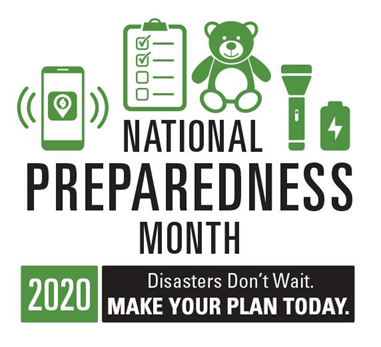Step 1: Put a plan together by discussing the questions below with your family, friends or household to start your emergency plan.
When starting to make a plan, include other people, particularly your family, in putting together a plan. It will help you cover areas that you might not think about and the other members of the family will feel they are an active part of the plan and that ownership will make moving forward in your preparedness much easier.
Local: House fire, flood
Regional: Natural disaster (Hurricane, Flood, Blizzard Tornado), Pandemic
If want a good source of scenarios, you can use the list in the Emergency Preparedness Worksheet Question 1b
- Home fire – kitchen / basement / storage room / garage fire
- Automobile accident
- Fire or explosion in a public place
- Vehicle trapped in a blizzard
- Mountain/ backcountry accident
- Boating or water accident
- Gas leak in a home or a building
- Tornado or hurricane
- Major flooding or a flash flood
- Toxic chemical spills and releases
- Violence in a public place
And one that is not
- Regional pandemic health event / pandemic
Don’t try to do them all, just the one or two that you and your family a most likely to come up against. Each time you review the plan, at least once a year, you can incorporate more scenarios to reflect how your family’s life has changed.
Depending on the scenario, determine if you can shelter in place or whether you might need to evacuate. Depending on the event, the you might need to evacuate when you plan to shelter in place or vice versa.
Step 2: Consider specific needs in your household.
Each family is different and has different needs and sizes.
- Does a member of your family have special needs such as medications or physical help in certain situations?
- Are there family members that have dietary specific needs?
- Is your normal family close together or spread out in different locations through the day? How will you gather, if that is possible? If gathering is not possible, how will you communicate to let your other family members know your location and if you are okay?
- If we have to evacuate? Where do we go? Can the place handle our needs?
- Are there family members that might be called upon to respond if an event occurs? How will that affect how the rest of the family responds?
Make sure to take those needs into account for both sheltering in place or evacuating.
Step 3: Fill out a Family Emergency Plan
While we all have this information “in our heads”, when a disaster strikes, a lot of times trying to remember while tying to act doesn’t always work well and takes time. Writing this information down helps you collect it to reduce your response time. It also helps to reinforce what you already know and learn the things that you do not.
– Do you know how you will get together? How will you communicate if you are not?
– Do you have a contact point person outside of your immediate household so that you can gather virtually?
– If there is a disaster, who do you call to respond?
– After the disaster, where can you go for shelter?
Ready.gov has an Emergency Plan document that you can use to gather that information to make sure that all family members have access to that information.
Emergency Plan for Parents (PDF)
Step 4: Practice your plan with your family/household
Practice makes perfect, or at least better. Hold a family meeting to discuss your plan. You don’t need to start crawling and jumping out windows to practice. Start with a tabletop exercise to talk it through together. The first rule in that discussion is to allow everyone to speak and ask serious questions without ridicule or being brushed aside because the answer is not readily available or known. Take those questions and put them in a “Parking lot” where they can be looked and addressed. You will find that some of them need to added to the plan.
Once you have a plan in mind, you can start to Build a kit to help you respond to that plan.
Resources
SUFFOLK COUNTY OFFICE OF EMERGENCY MANAGEMENT
Ready.gov Make a Plan – Additional Resources



